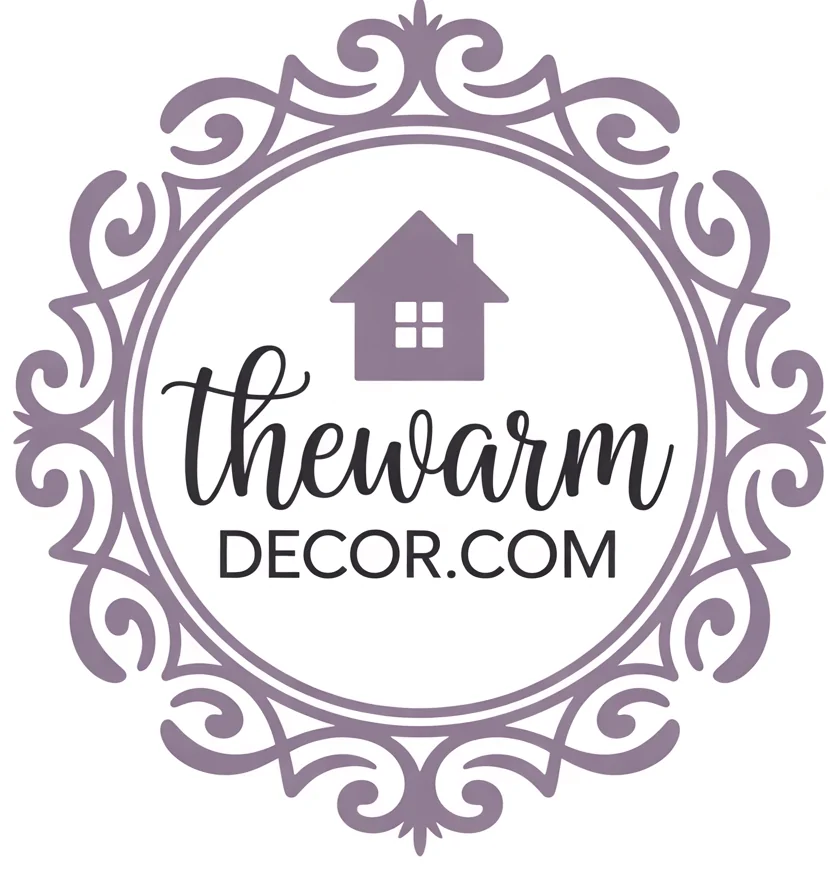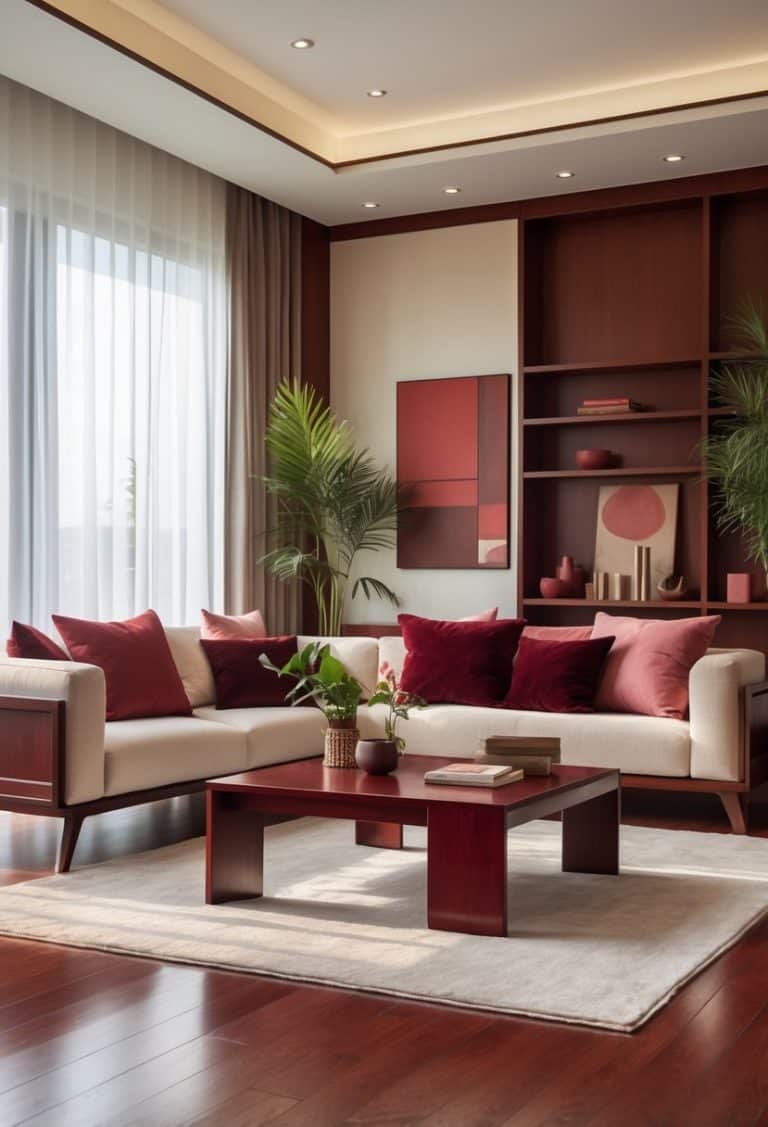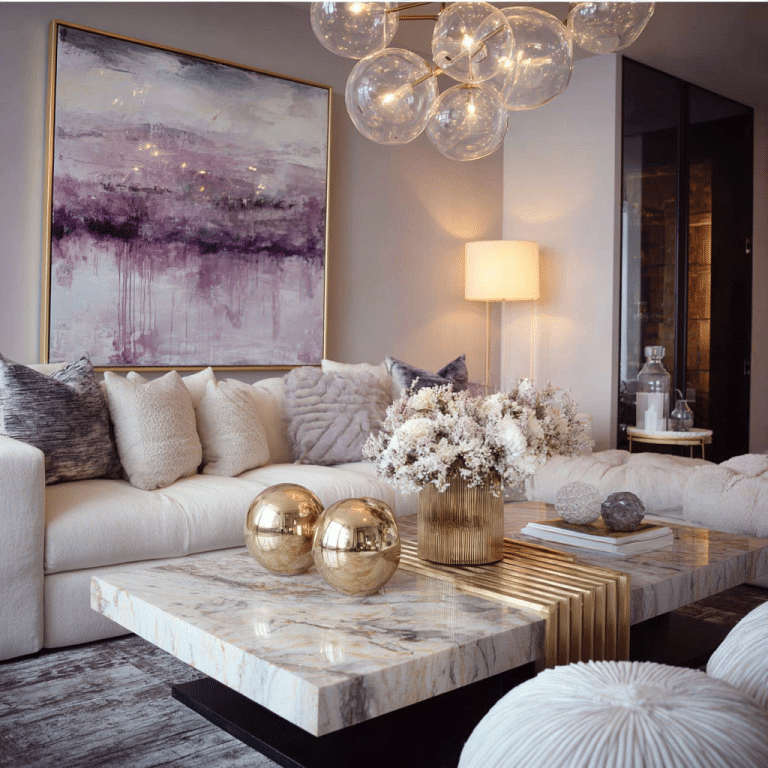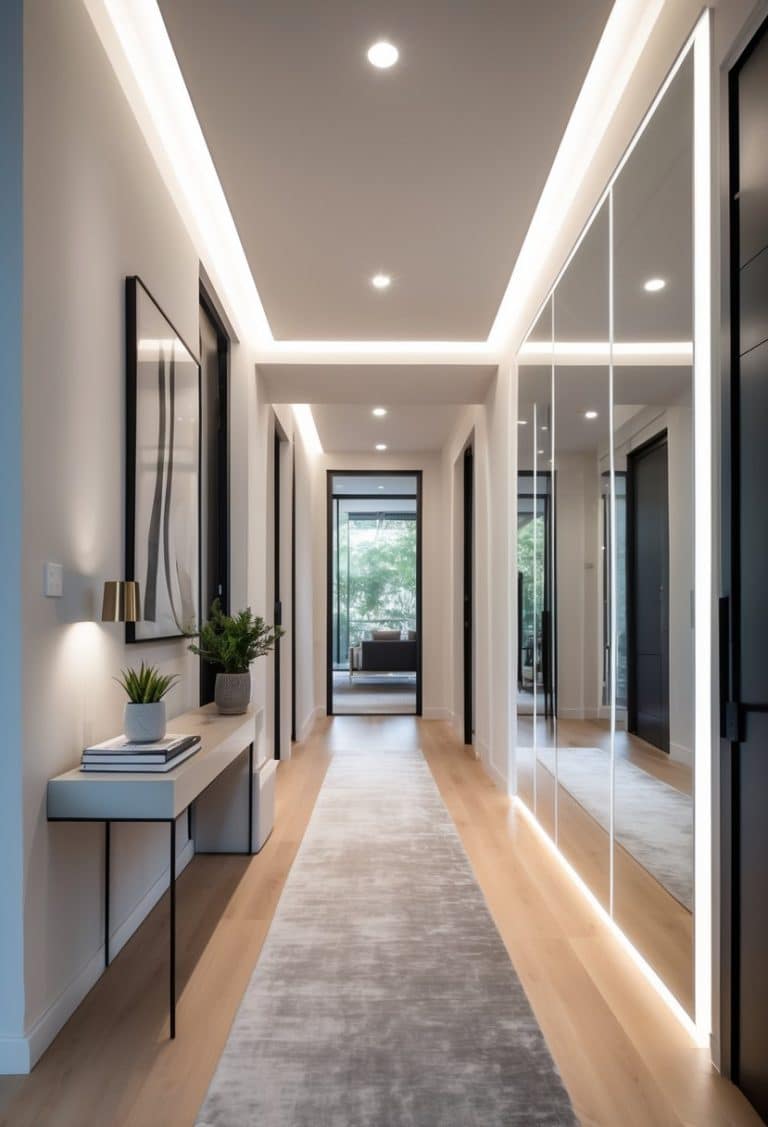22 Castlecore Hallway Inspiration Ideas for Timeless Interior Design

Castlecore design brings a touch of medieval charm into everyday spaces, and hallways offer the perfect setting to showcase this style. With their role as connecting spaces, hallways can set the tone for the rest of a home while adding character and atmosphere. A Castlecore hallway combines historical inspiration with practical design, creating a space that feels both timeless and welcoming.

This approach does not aim to recreate the past exactly but instead blends gothic and medieval details with modern comfort. Through architectural elements, textured finishes, and carefully chosen accents, a hallway can shift from plain and functional to rich with personality and depth.
1) Stone archways framing the hallway entrance

Stone archways give a hallway entrance a solid and lasting look. They create a clear transition between spaces while adding visual weight.
Different stones, such as limestone or granite, provide unique textures and tones. Their natural variation makes each arch distinct.
These features also connect with Castlecore design by echoing medieval architecture. They balance strength with subtle decorative detail.
2) Stained glass windows with medieval patterns

Stained glass windows bring color and texture into a hallway. They filter natural light into soft patterns that change throughout the day.
Medieval designs often feature geometric shapes, floral motifs, or simple heraldic symbols. These patterns add historic character without overwhelming the space.
Even small panels or inserts can create a subtle medieval effect in a modern hallway.
3) Wrought iron chandeliers with candle-style bulbs

Wrought iron chandeliers with candle-style bulbs add a traditional look to hallways. Their simple metal frames pair well with stone or wood details often found in castle-inspired spaces.
The candle-style bulbs give the appearance of old candelabras while still offering modern electric lighting. This balance keeps the hallway practical and visually consistent.
4) Heavy velvet draperies in jewel tones

Velvet draperies in deep jewel tones add weight and texture to a hallway. Shades like emerald, burgundy, and navy create a rich backdrop against stone or wood surfaces.
These fabrics not only frame doorways or windows but also help soften the harder architectural elements often found in castle-inspired interiors.
5) Antique-style wooden benches with carved details

Antique-style wooden benches with carved details add character to a hallway. Their craftsmanship often shows in oak, walnut, or pine.
These benches provide both seating and decorative value. Carved patterns can range from simple lines to ornate motifs, fitting well with castle-inspired interiors.
They work well in narrow spaces. Many designs echo European traditions, including Gothic and Renaissance styles.
6) Tapestries depicting medieval scenes

Tapestries with medieval scenes add both decoration and function to a hallway. They soften stone or plaster walls while introducing color and texture.
Designs often feature battles, folklore, or daily life, giving the space a clear historical reference. These details help reinforce the castlecore aesthetic without overwhelming the area.
7) Mosaic tile flooring with intricate geometric designs

Mosaic tile flooring uses small shapes arranged in repeating patterns. These designs often feature squares, triangles, or hexagons placed in precise layouts.
In hallways, geometric mosaics create visual interest while maintaining durability. Many Victorian and modern styles highlight black and white contrasts, though subtle color accents also work well.
8) Iron wall sconces with gothic motifs

Iron wall sconces with gothic details add structure and character to a hallway. Their dark metal frames and simple candle-style lights fit well with medieval-inspired interiors.
They work best on stone or textured walls, where the contrast highlights their shapes. Pairs or sets can create balance along longer corridors.
9) Carved wooden paneling along the walls

Carved wooden paneling adds depth and texture to a hallway. It creates visual interest while keeping the space grounded in a traditional style.
Many designs feature repeating patterns or simple motifs that complement stone or fabric accents. This detail works well with both darker wood tones and lighter finishes.
The paneling also pairs easily with tapestries, chandeliers, or antique furniture, helping the hallway feel cohesive and refined.
10) Decorative wrought iron coat hooks

Wrought iron coat hooks add both function and character to a hallway. Their sturdy build makes them reliable for holding coats, bags, or scarves.
Many designs feature hand-forged details, giving them a simple yet historic look. They fit well with castle-inspired interiors and blend with rustic or traditional decor.
11) Vintage suits of armor as hallway accents

Placing a vintage suit of armor in a hallway creates a strong focal point. It reflects the medieval influence central to the Castlecore style.
Smaller pieces, like helmets or shields, can serve as subtle accents. These items add historical detail without overwhelming narrow spaces.
12) Goth-glam candelabra on console tables

Placing a candelabra on a console table adds a clear focal point in a hallway. The tall structure and multiple arms create balance against the table’s flat surface.
Many choose dark metal or antique finishes to match the castlecore look. Paired with candles, it gives the space a warm, moody glow.
13) Stone or faux-stone textured wallpaper

Stone or faux-stone wallpaper adds depth and character to a hallway without major renovation. It gives the look of traditional masonry while remaining easy to install.
Peel-and-stick options work well for renters, while textured finishes can create a more permanent effect. Both choices help achieve a subtle castle-inspired style.
14) Arched doorways with rustic wooden doors

Arched doorways paired with rustic wooden doors create a strong architectural feature in castlecore hallways. The curved shape softens the structure while the wood adds warmth and texture.
They often use natural finishes, visible grain, and sturdy hardware. This combination blends medieval influence with practical durability, fitting seamlessly into a castle-inspired interior.
15) Natural fiber rugs with medieval patterns

Natural fiber rugs add warmth and texture to a hallway while keeping the space grounded.
Patterns inspired by medieval designs, such as geometric borders or stylized floral motifs, create a subtle historical touch.
These rugs work well with stone, wood, or dark-toned walls, enhancing the castlecore aesthetic without overwhelming the space.
16) Heavy wooden console tables with iron accents

These tables combine solid wood surfaces with sturdy iron frames or details. The mix of materials creates a balanced look that feels both traditional and practical.
They work well in hallways where durability matters. The iron provides stability, while the wood adds warmth and texture to the space.
17) Medieval-inspired stained glass mirrors

Stained glass mirrors bring color and light into narrow hallways. They reflect natural light while adding a medieval touch.
Designs often include simple geometric shapes or floral patterns. These details echo the craftsmanship found in historic castles.
Placed opposite a window, the mirrors brighten the space and highlight architectural features.
18) Chainmail-inspired metal wall art

Chainmail-inspired wall art adds a textured, metallic element that fits well with Castlecore hallways. The interlocking rings create a structured pattern that recalls medieval armor.
This type of decor works as a focal point or as subtle accents along a hallway wall. It blends historical reference with modern design.
19) Velvet cushions with embroidered heraldic symbols

Velvet cushions with heraldic embroidery add a formal and traditional touch to a hallway bench or chair.
These designs often feature crests, coats of arms, or motifs stitched in metallic threads.
They work well in castlecore interiors by reinforcing a historic and stately atmosphere.
20) Decorative wrought iron stair railings

Decorative wrought iron stair railings add structure and detail to castlecore hallways. Their dark metal tones pair well with stone walls and wooden floors.
They can feature simple lines or more ornate scrollwork. This flexibility allows them to fit both modest and more elaborate medieval-inspired spaces.
The material is durable and provides safety while also serving as a visual accent.
21) Antique brass door knockers

Antique brass door knockers add a traditional detail to a hallway. Their weight and finish give a sense of age and craftsmanship.
They can be mounted on interior or entry doors to highlight a Castlecore theme. The warm brass tone pairs well with stone, wood, and wrought iron.
22) Dark wood flooring with distressed finish

Dark wood flooring with a distressed finish adds depth and texture to a hallway. The worn look creates a sense of age that fits naturally with Castlecore style.
The darker tones pair well with stone walls, archways, and wrought iron details. This flooring also helps hide scuffs and wear in busy spaces.
Key Elements of Castlecore Hallway Design

Castlecore hallways rely on historical details, rich textures, and balanced lighting to create a space that feels both timeless and practical. Stone, wood, and textiles work together with muted jewel tones and soft illumination to echo the character of medieval interiors while remaining functional for daily use.
Architectural Features
Castlecore design often begins with structural details that set the tone of the hallway. Arched doorways and stone or plaster walls bring in the look of medieval architecture. Exposed wooden beams or paneled ceilings add depth and warmth.
Floors play a major role. Stone tiles, mosaic patterns, or dark wood planks give the hallway a grounded, sturdy presence. These materials also handle heavy use well.
Decorative elements like carved trim, wrought iron railings, and alcoves for statues or candles reinforce the historical feel. Even in modern homes, these features can be adapted with veneer stone, faux beams, or reproduction hardware to achieve a similar effect.
Color Palettes and Materials
Color choices lean toward deep, muted shades that recall natural pigments. Emerald green, burgundy, navy, and charcoal stand out as common tones. These colors pair well with neutral stone grays or warm wood browns.
Materials focus on durability and texture. Stone, brick, and wood create the foundation, while textiles soften the look. Heavy fabrics such as velvet, wool, or tapestry-style wall hangings add warmth and visual interest.
Metal details also matter. Wrought iron handles, sconces, or decorative grilles provide contrast against softer surfaces. When combined, these materials create a layered look that feels authentic without being overwhelming.
Lighting Strategies
Lighting in a Castlecore hallway emphasizes mood over brightness. Instead of harsh overhead fixtures, softer sources such as sconces, lanterns, or candle-style lights create a gentle glow. Iron or bronze finishes on fixtures help tie them to the overall theme.
Natural light, when available, enhances the atmosphere. Stained glass inserts or leaded windows filter sunlight into colorful patterns. This effect adds both decoration and function.
For long or narrow hallways, lighting should be placed at intervals to avoid dark spots. A mix of wall-mounted fixtures and low-level accent lights ensures the space feels welcoming while maintaining the dramatic tone of Castlecore design.
Incorporating Vintage and Modern Touches

Blending old-world character with updated details creates a hallway that feels both timeless and functional. The right mix of antique elements and modern updates allows the space to stay true to castlecore style while remaining practical for daily use.
Antique Accents
Vintage pieces bring depth and authenticity to a castlecore hallway. Items like wrought iron sconces, gilded mirrors, or stone pedestals add historical weight without overwhelming the space. Even small touches, such as aged brass hooks or carved wooden frames, can reinforce a medieval mood.
Tapestries and textiles also play a major role. A hallway lined with woven wall hangings or velvet runners adds warmth and texture. These pieces not only soften stone or wood surfaces but also highlight craftsmanship often missing in modern interiors.
Furniture choices can further ground the look. A narrow antique console table or a weathered bench offers both utility and charm. When paired with candleholders or ceramic vessels, the space feels layered and lived in.
Contemporary Adaptations
Modern details help balance the heaviness of vintage decor. Clean-lined furniture, slim lighting fixtures, or neutral paint colors prevent the hallway from feeling too dark or crowded. Subtle updates allow the space to remain inviting while still nodding to its medieval inspiration.
Lighting is especially important. Instead of relying only on candles, homeowners can use LED sconces or recessed lighting that mimic warm candlelight but provide better visibility. This maintains atmosphere without sacrificing comfort.
Practical materials also make a difference. Durable flooring like engineered wood or stone-look tile recreates the right aesthetic while being easier to maintain. By mixing these modern solutions with antique accents, the hallway achieves balance between style and usability.






